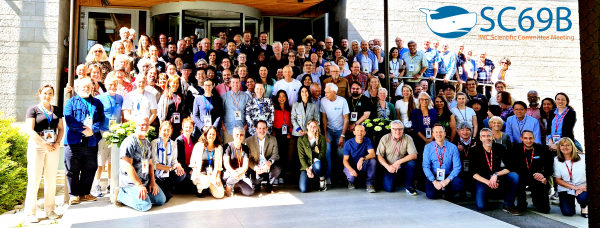From indigenous whaling to Iberian killer whales:
the IWC Scientific Committee reports on another busy and wide-ranging meeting
The 2024 IWC Scientific Committee report is published today.
The Committee includes world-leading experts in a range of scientific fields related to whales, dolphins and porpoises, known collectively as cetaceans. The purpose of the meeting and subsequent report is to ensure that the Commission is equipped with the latest scientific information when it takes decisions related to cetacean management and conservation at its next meeting in September.
Over 240 participants gathered in Bled, Slovenia, or made valuable, virtual contributions. Topics discussed ranged from plastic pollution and climate change to recent interactions between vessels and Iberian killer whales.
Many core programmes are long-standing and ongoing. They include modelling and assessment work to establish the size, structure and health of cetacean populations. This information is crucial to the Committee and used by all of its groups to understand the overall status of different populations and identify areas or activities that negatively impact whales. During the meeting, four new estimates of abundance were endorsed and will be added to the IWC’s published table of estimates.
A long-term programme to conduct detailed assessments of particular species and regions is another core responsibility of the Committee. This year’s meeting completed assessments for North Pacific humpback and sei whales, and made excellent progress on assessments for western North Pacific common minke and Antarctic blue whales.
Another key task for the Committee at this meeting was to provide scientific advice on Aboriginal Subsistence hunts which will be discussed at the next meeting of the Commission. These hunts are not conducted for profit but to meet the nutritional and cultural needs of communities in remote Arctic regions.
The Committee rigorously tests different hunting scenarios that include quotas for every animal struck, whether or not it is caught and landed. These are referred to as Strike Limit Algorithms or SLAs. Computer simulations test SLAs over a 100 year period to ensure the hunts will not harm whale populations in the long-term. The simulations also account for the inevitable uncertainty regarding factors such as whale population structure and environmental conditions. All relevant information is reviewed on a rolling basis to assess whether new developments related to any of these factors require further scrutiny or testing.
Strike limits are established in six year blocks. At the end of each block, the Committee provides the Commission with its assessment of the quotas against this extensive programme of testing. At the meeting, the Committee completed this work and was able to report that the existing strike limits will not harm the targeted whale populations.
The Committee also provides advice to both the Commission and the Conservation Committee on Conservation Management Plans (CMPs), a framework developed by the IWC for countries and other stakeholders to protect and rebuild vulnerable populations. Five CMPs are currently underway and four more proposals were endorsed at the meeting.
The Iberian killer whale, whose recent interactions with vessels have generated media attention and public concern, was proposed as a priority population for the development of a CMP. Occurring within the waters of France, Morocco, Portugal and Spain, the Iberian population numbers some 40 individuals and is considered critically endangered by IUCN. Vessel interactions typically involve vigorously pushing the rudder, sinking some vessels and rendering others unnavigable. Members of the Committee are already engaged in work to assess this unique behaviour and develop mitigation measures.
The Committee made progress on many other topics including:
- bycatch and entanglement, where new guidelines were endorsed for responding to entangled, free swimming small cetaceans;
- a review of the Southern Ocean Sanctuary (SOS) which concluded that the sanctuary meets its objectives and serves as an incentive for cutting edge polar research on whales and their ecosystems;
- climate change, where the relationships between climate change, strandings and unusual mortality events were noted, including a decline in Alaskan populations of North Pacific humpbacks which was linked to extreme marine heatwaves;
- multi-stranded efforts to make the work of the Committee more accessible to the public and to other organisations concerned with science, management and conservation of cetaceans and the marine environment.
You can read about more about these topics and many others in the full Report of the 2024 Scientific Committee Meeting SC69B

